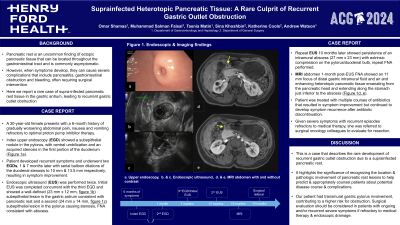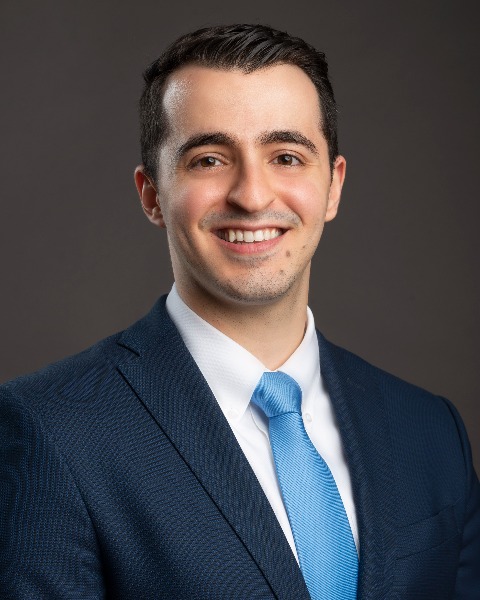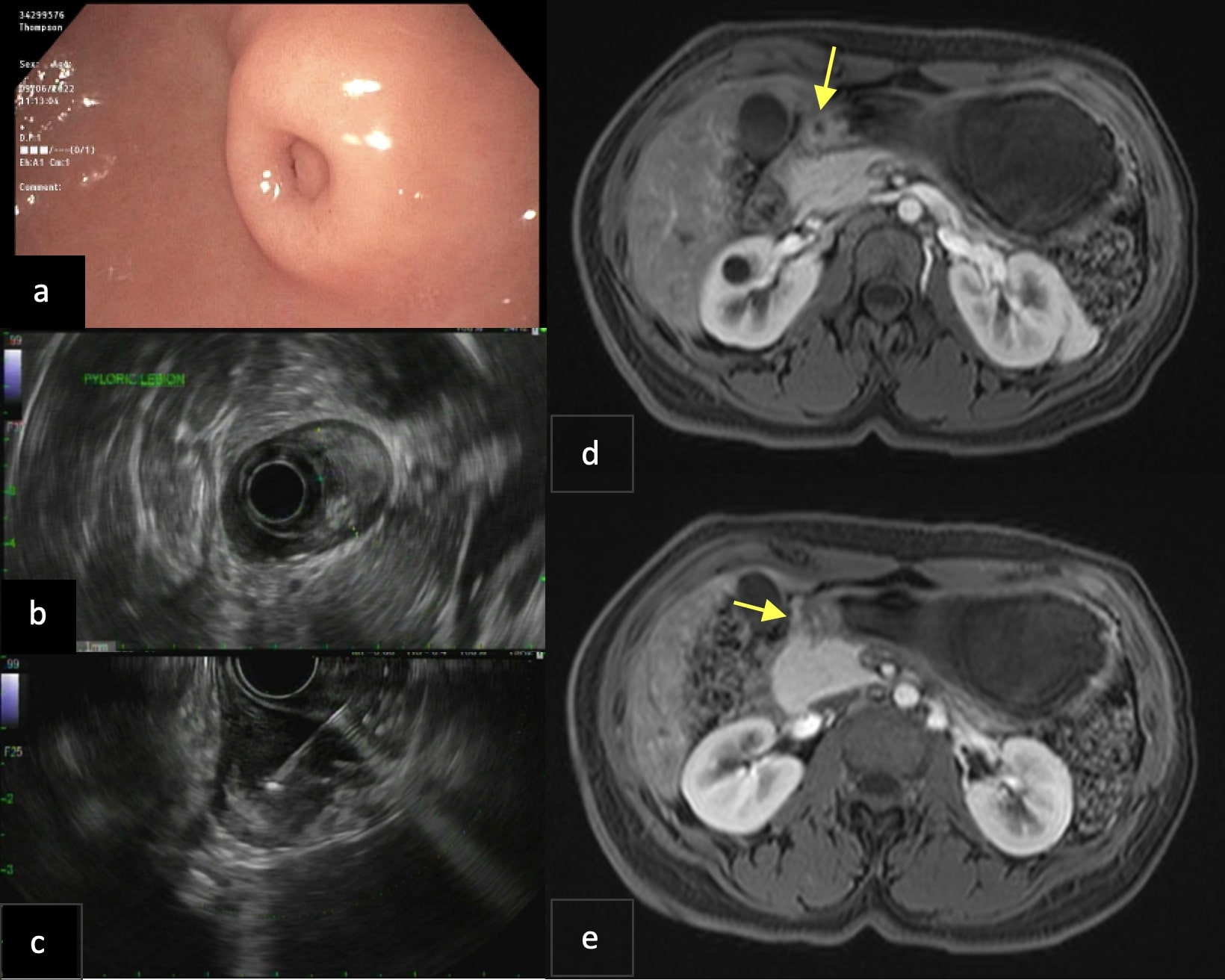Sunday Poster Session
Category: Biliary/Pancreas
P0184 - Suprainfected Heterotopic Pancreatic Tissue: A Rare Culprit of Recurrent Gastric Outlet Obstruction
Sunday, October 27, 2024
3:30 PM - 7:00 PM ET
Location: Exhibit Hall E

Has Audio

Omar Shamaa, MD
Henry Ford Health
Detroit, MI
Presenting Author(s)
Award: Presidential Poster Award
Omar Shamaa, MD, Muhammad Salman Faisal, MD, Tasnia Matin, MD, Sina Khoshbin, MD, Katherine Cools, MD, MS, Andrew Watson, MD
Henry Ford Health, Detroit, MI
Introduction: Pancreatic rest (PR) is an uncommon finding of ectopic pancreatic tissue that can be located throughout the gastrointestinal tract and is commonly asymptomatic. However, when symptoms develop, they can cause severe complications that include pancreatitis and gastrointestinal obstruction. Here we report a rare case of supra-infected pancreatic rest tissue in the gastric antrum, leading to recurrent gastric outlet obstruction.
Case Description/Methods: A 30-year-old female presents with a 6-month history of worsening abdominal pain, nausea and vomiting refractory to proton pump inhibitor therapy. Index upper endoscopy (EGD) showed a subepithelial nodule in the pylorus, with central umbilication and stenosis in the first portion of the duodenum (Figure 1a). The patient developed recurrent symptoms and underwent two EGDs, 1 & 7 months later with serial balloon dilations of the duodenal stenosis to 10 mm & 12.5 mm respectively. Due to persistent stenosis and recurrent symptoms, endoscopic ultrasound (EUS) was performed twice, initially showing a well-defined (23 x 12 mm, figure 1b) subepithelial lesion in the gastric antrum consistent with pancreatic rest and a second (24 x 14 mm, figure 1c) subepithelial lesion in the pylorus causing stenosis, FNA consistent with abscess. Repeat EUS 10 months later showed persistent intramural abscess (27 x 23 mm) with extrinsic compression on the pylorus, repeat FNA drainage was performed. MRI abdomen 1 month post-EUS FNA showed an 11 mm distal gastric intramural abscess (Figure 1d) and heterotopic pancreatic tissue emanating from the pancreatic head and extending along the stomach inferior to the abscess (Figure 1e). Patient was treated with multiple courses of antibiotics that resulted in symptom improvement, but continued to develop symptom recurrence after antibiotic discontinuation. Given severe symptoms with recurrent episodes refractory to medical therapy, she was referred to surgical oncology to evaluate for resection.
Discussion: This case describes the rare development of recurrent gastric outlet obstruction due to a suprainfected PR. It highlights the significance of recognizing the location & pathologic involvement of PR lesions to help predict & appropriately counsel patients about the potential disease course. Our patient had transmural gastric pylorus involvement, contributing to a higher risk for obstruction. Surgical evaluation should be considered in patients with recurrent severe symptoms if refractory to medical and endoscopic treatment.

Disclosures:
Omar Shamaa, MD, Muhammad Salman Faisal, MD, Tasnia Matin, MD, Sina Khoshbin, MD, Katherine Cools, MD, MS, Andrew Watson, MD. P0184 - Suprainfected Heterotopic Pancreatic Tissue: A Rare Culprit of Recurrent Gastric Outlet Obstruction, ACG 2024 Annual Scientific Meeting Abstracts. Philadelphia, PA: American College of Gastroenterology.
Omar Shamaa, MD, Muhammad Salman Faisal, MD, Tasnia Matin, MD, Sina Khoshbin, MD, Katherine Cools, MD, MS, Andrew Watson, MD
Henry Ford Health, Detroit, MI
Introduction: Pancreatic rest (PR) is an uncommon finding of ectopic pancreatic tissue that can be located throughout the gastrointestinal tract and is commonly asymptomatic. However, when symptoms develop, they can cause severe complications that include pancreatitis and gastrointestinal obstruction. Here we report a rare case of supra-infected pancreatic rest tissue in the gastric antrum, leading to recurrent gastric outlet obstruction.
Case Description/Methods: A 30-year-old female presents with a 6-month history of worsening abdominal pain, nausea and vomiting refractory to proton pump inhibitor therapy. Index upper endoscopy (EGD) showed a subepithelial nodule in the pylorus, with central umbilication and stenosis in the first portion of the duodenum (Figure 1a). The patient developed recurrent symptoms and underwent two EGDs, 1 & 7 months later with serial balloon dilations of the duodenal stenosis to 10 mm & 12.5 mm respectively. Due to persistent stenosis and recurrent symptoms, endoscopic ultrasound (EUS) was performed twice, initially showing a well-defined (23 x 12 mm, figure 1b) subepithelial lesion in the gastric antrum consistent with pancreatic rest and a second (24 x 14 mm, figure 1c) subepithelial lesion in the pylorus causing stenosis, FNA consistent with abscess. Repeat EUS 10 months later showed persistent intramural abscess (27 x 23 mm) with extrinsic compression on the pylorus, repeat FNA drainage was performed. MRI abdomen 1 month post-EUS FNA showed an 11 mm distal gastric intramural abscess (Figure 1d) and heterotopic pancreatic tissue emanating from the pancreatic head and extending along the stomach inferior to the abscess (Figure 1e). Patient was treated with multiple courses of antibiotics that resulted in symptom improvement, but continued to develop symptom recurrence after antibiotic discontinuation. Given severe symptoms with recurrent episodes refractory to medical therapy, she was referred to surgical oncology to evaluate for resection.
Discussion: This case describes the rare development of recurrent gastric outlet obstruction due to a suprainfected PR. It highlights the significance of recognizing the location & pathologic involvement of PR lesions to help predict & appropriately counsel patients about the potential disease course. Our patient had transmural gastric pylorus involvement, contributing to a higher risk for obstruction. Surgical evaluation should be considered in patients with recurrent severe symptoms if refractory to medical and endoscopic treatment.

Figure: Figure 1. a, Index upper endoscopy; b & c, Endoscopic ultrasound; d & e, MRI abdomen
Disclosures:
Omar Shamaa indicated no relevant financial relationships.
Muhammad Salman Faisal indicated no relevant financial relationships.
Tasnia Matin indicated no relevant financial relationships.
Sina Khoshbin indicated no relevant financial relationships.
Katherine Cools indicated no relevant financial relationships.
Andrew Watson: Cook Medical – Consultant.
Omar Shamaa, MD, Muhammad Salman Faisal, MD, Tasnia Matin, MD, Sina Khoshbin, MD, Katherine Cools, MD, MS, Andrew Watson, MD. P0184 - Suprainfected Heterotopic Pancreatic Tissue: A Rare Culprit of Recurrent Gastric Outlet Obstruction, ACG 2024 Annual Scientific Meeting Abstracts. Philadelphia, PA: American College of Gastroenterology.

